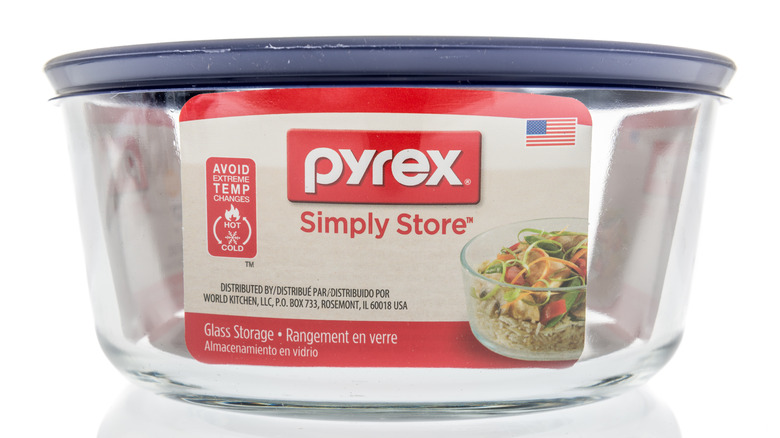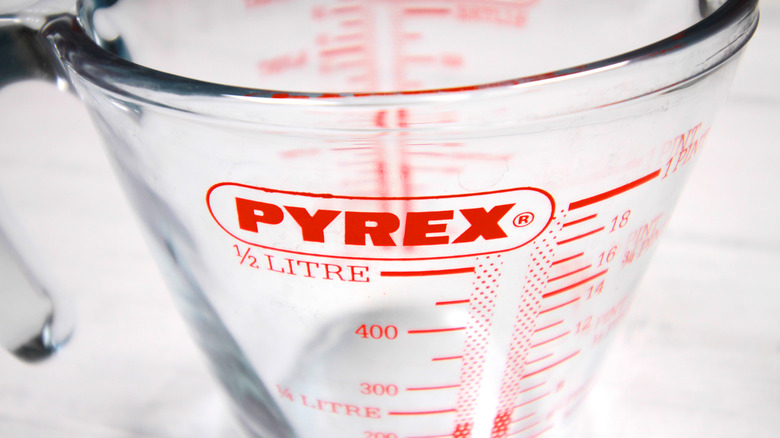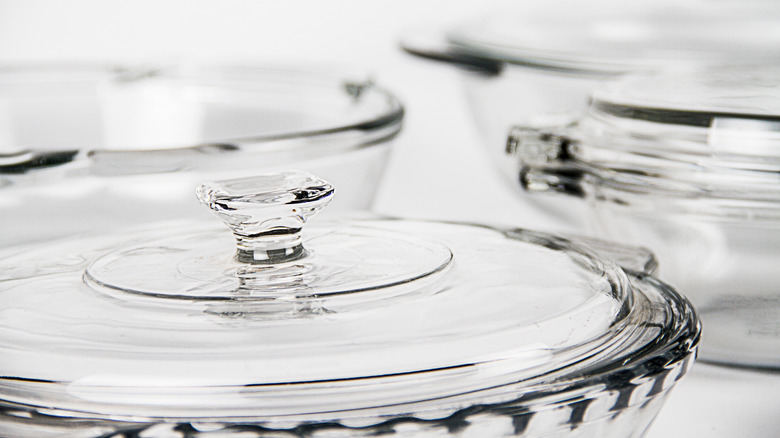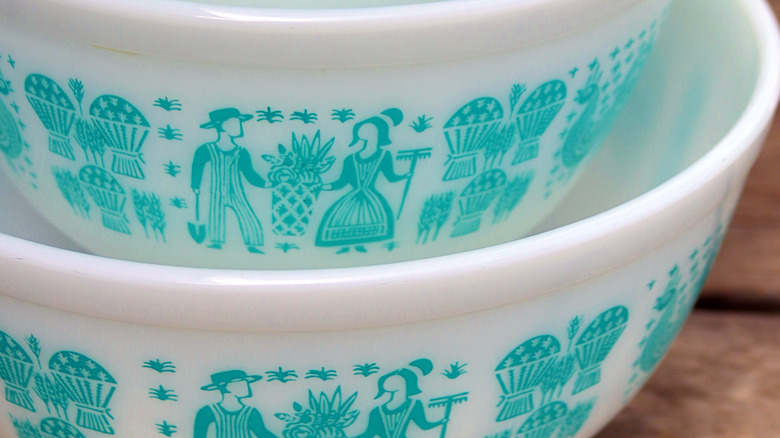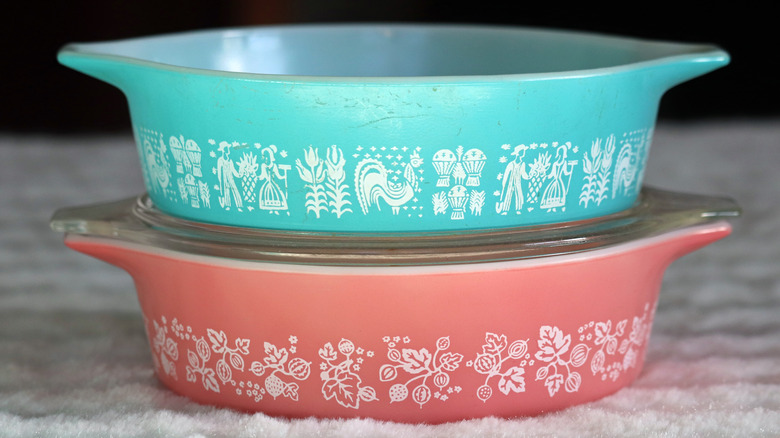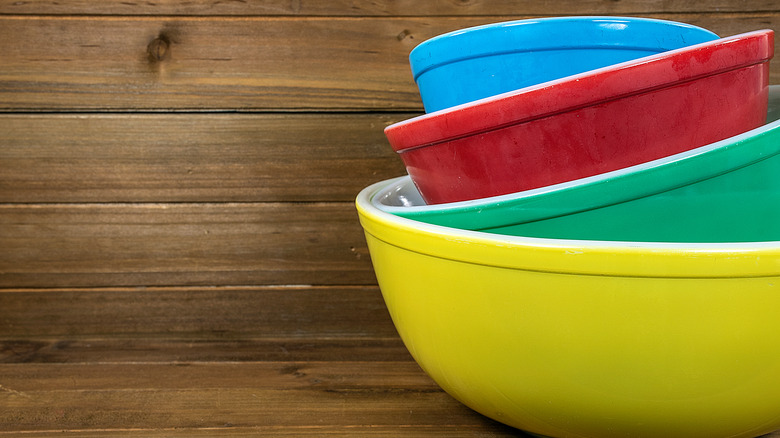The Untold Truth Of Pyrex
We may receive a commission on purchases made from links.
As lovers of food and cooking, stocking our kitchens with stylish and high-performing cooking equipment is something we love to do. While it takes time — and some expense — to build a kitchen arsenal, it's a task that we enjoy, whether that means scouring the internet for deals or perusing kitchen supply stores, thrift stores, and yard sales. Broadly speaking, some of the kitchen workhorses we rely on include sharp chef's knives, cast iron pans, and stainless steel skillets.
And when it comes to bakeware, we — and many other accomplished chefs and home cooks — love Pyrex. This heat-and-cold-resistant glassware is a kitchen staple for many, available in the form of mixing bowls, casserole dishes, mugs, and more, and coming in stylish patterns that were all the rage in the 1950s and '60s — and is a favorite collectors' item today (via Eater). Introduced in 1915 by Corning Inc., Pyrex revolutionized home cooking for many Americans, who had become accustomed to glass dishes shattering in ovens, on stovetops, and in refrigerators. Read on to learn more about the story behind Pyrex — and why so many cooks love it.
A new kind of glass
According to Pyrex's official website, the company's origins began in 1887, when German scientist Otto Schott experimented with adding boron oxide into glass to make it more resistant to extreme temperatures. W.C. Taylor, a chemist with the American glassmaker Corning Inc., discovered Schott's formula and improved upon it, resulting in a heat-and-cold-resistant glass that the company called Nonex. Nonex's first practical application was in railroad signaling lanterns, which used to burst when snowflakes fell on them; now, they could endure the temperature extremes, and lasted much longer (via Pyrex).
It wasn't until a few decades later that borosilicate glass made its entrance into the kitchen. In 1915, according to Pyrex, Bessie Littleton, wife of Corning engineer Jessie, asked for glass samples from her husband's lab to try to make a cake in one of them. Tired of glass pans and dishes breaking in her oven when exposed to high heat, Littleton figured that borosilicate glass might have a place in her kitchen. She was right: the Savoy cake she baked in a sample pan came out great, and the pan survived, too.
The birth of Pyrex
After testing out her cake in a borosilicate pan, Bessie Littleton tried out a whole bunch of other dishes, ranging from potatoes to roasted meat (via Pyrex). She found that this new type of glass didn't shatter in the oven, and encouraged her husband's employer to launch a line of cookware with it. Since the first piece of equipment the company fabricated was a pie plate, and the type of glass they were using was called Nonex, the new line of glass kitchenware was christened Pyrex (via Pyrex). In 1916, the new company began marketing its pie plates, and soon began making roasting dishes and casseroles as well.
Home cooks soon clamored for the dishes, which were resistant to cold as well as heat, meaning they could transfer seamlessly from fridge to oven to table. According to Pyrex Collector, the new brand sold more than 4 million pieces in its first four years of production, and an additional 26 million over the next eight years.
Pyrex in advertisements
As Pyrex dishes made their way into more and more American as well as international households, the company expanded its advertisements for its new product — sometimes resulting in some interesting concepts. A 1948 ad (posted at Trove) in The Australian Women's Weekly, for example, depicted an overflowing Pyrex casserole as "Man-bait!" with an apron-clad female cook gleefully preparing to rope in a number of well-dressed suitors interested in her cooking.
Many ads focused more straightforwardly on the glassware's advantages in the kitchen. An early 1918 ad (via The Vintage Inn) noted that "Everything bakes better" — "Meats, even the cheaper cuts, are tender and appetizing ... Fruits and vegetables keep their fresh color and flavor." And a 1940s advertisement (also posted at The Village Inn) emphasized the magical quality of cooking in glass on the stovetop: "It's beautiful to watch green beans or asparagus cooking in a Pyrex Flameware saucepan. You feel like a magician, putting glass over an open flame and knowing it won't break."
Pyrex brings style to the kitchen
As it gained attention for its practicality in the kitchen, Pyrex cookware also turned heads for the stylish patterns the company began using on its bowls, casseroles, and other dishware. Having started out producing clear glass dishes, Pyrex went on to develop an opaque glass to which lots of color could be applied, according to Smithsonian Magazine. Pyrex went on to create more than 150 distinct designs.
"In the post-war period, you have this explosion of color in the kitchen, and the mixing and matching of colors in tableware," Juliet Kinchin, curator of modern design at the Museum of Modern Art, told Smithsonian. "That's also when the barrier between the kitchen and other spaces broke down; the kitchen became a communal space. With new, spacious kitchen designs, dishes were on view for all to see."
Some of Pyrex's more recognizable patterns include a set of nesting mixing bowls that are white on the inside and brightly colored on the outside; pale pink dishes with white daisies; turquoise dishes with white snowflakes; and white dishes with coral-colored strands of gooseberries (and vice-versa).
Pyrex: a collector's item
Pyrex cookware is still a favorite with home cooks to this day. It remains a practical, high-performing, and affordable option, with items such as its clearly marked measuring cups, its lidded nesting storage containers, and its timeless casserole dishes among the favorites of chefs and amateurs alike. But beyond modern-day Pyrex which can be purchased in many stores and on many websites, vintage Pyrex glassware is also an extremely hot-ticket item for collectors around the globe.
Timeless colored Pyrex pieces and the patterns mentioned above are highly sought-after in thrift stores, at yard sales, and, of course, on eBay. An eBay search for "vintage Pyrex" brings up those colorful mixing bowls, flamingo-pink lidded casseroles, a white butter dish printed with a turquoise homesteading theme, a drinks pitcher emblazoned with lemons and limes, and much more. Want some pieces for yourself? Just be aware that after the success of television series that take place in the 1950s and '60s, such as "Mad Men" and "The Marvelous Mrs. Maisel," vintage Pyrex surged in popularity, and can be tough to find these days (via Eater).
"The market is definitely different," Jennifer Ashley, author of the book "Shiny Happy Pyrex People," told Eater. "You have more competition for each piece, especially among collectors, and thrift stores like Goodwill now have their own auction sites."
